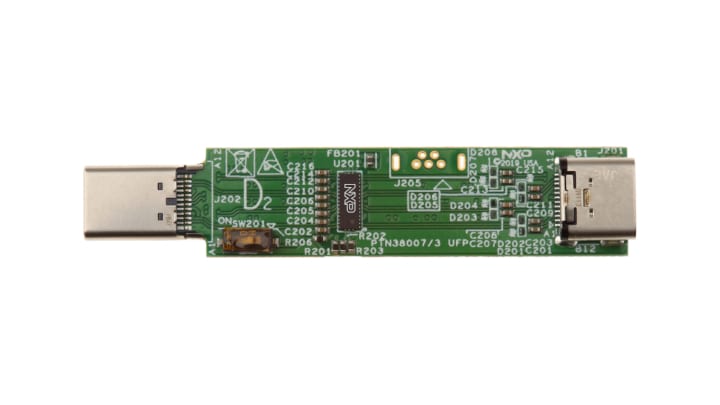Getting Started with the PTN38007/PTN38003 Evaluation Board
Contents of this document
-
Get Started
-
Get to Know the Hardware
-
Configure the Hardware
Sign in to save your progress. Don't have an account? Create one.

Purchase your PTN38007-EVM Evaluation Board
Get Started
The NXP analog product development boards provide an easy-to-use platform for evaluating NXP products. The boards support a range of analog, mixed-signal and power solutions. They incorporate monolithic integrated circuits and system-in-package devices that use proven high-volume technology. NXP products offer longer battery life, a smaller form factor, reduced component counts, lower cost and improved performance in powering state-of-the-art systems.
This page will guide you through the process of setting up and using the PTN38007/ PTN38003 evaluation board.
1.1 Kit Contents/Packing List
The kit contents include:
- Assembled and tested evaluation board in an anti-static bag
- Quick Start Guide
1.2 Minimum System Requirements
This evaluation board requires a Windows PC workstation. Meeting these minimum specifications should produce great results when working with this evaluation board.
- One PC/Notebook with USB-C supporting USB3.2 Gen1/2, DisplayPort, Thunderbolt 3 (PTN38007 only), or USB4 (PTN38007 only). A USB-A connector is needed to configure EVM via micro USB cable.
- Corresponding device for evaluation: USB3.2 Gen1/2, DisplayPort monitor, Thunderbolt 3 (PTN38007 only), or USB4 (PTN38007 only)
- One Type-C cable to connect between EVM and device
- One micro USB cable to connect EVM to a PC
- EVK board
- GUI
Get to Know the Hardware
2.1 Board Features
Benefits:
- Type-C plug to connect to a PC (H2 board) or a device (D2 board)
- Type-C receptacle to connect to a device (H2 board) or a Host (H2 board) via USB-C cable
- USB-to-I2C bridge to configure EVM via PC's GUI
2.2 Board Description
There are two boards included in the EVM package: a H2 board and a D2 board. The H2 board (or DFP board) is intended to plug into a notebook or PC and connect to a device via a USB-C cable. The D2 board (or UFP board) is intended to plug into a device or monitor and connect to a notebook or PC via a USB-C cable.
An included USB-2-I2C module is used to configure the EVM via a GUI running on a host PC.
PTN38007 EVMs can be used to evaluate USB3, DisplayPort, Thunderbolt3 and USB4 interfaces. The PTN38003A EVMs can only support USB3 and DisplayPort interfaces.
2.3 Board Components
Overview of the evaluation board


Configure the Hardware

PTN38007/3 P2R application board and LPCUSBSIO module should be connected together such that J103 is mated with J307, and J104 is
mated with J306. Use J101 to connect to host side, and J102 to connect to device side.
A micro-USB cable should be connected to J301 on the LPCUSBSIO module to provide power to the entire setup. This USB cable allows the use of NXPs LPCUSBSIO
USB-2- I2>C bridge to communicate with PTN38007/3’s I2C via USB2 interface. The user can download PTN38007/PTN38003A GUI from the Design Resources
section of this guide. It is recommended to first flash the LPCUSBSIO module with the latest firmware, which is located under the GUI package firmware directory. Refer
to UM11595 for details on how to flash the firmware.
In the GUI package, there are directories for H2 board (PTN3800x DFP) and D2 board (PTN3800x UFP). Execute the GUI that matches the correct hardware. There are default script files that are already pre-loaded in each directory based on the hardware type. If the wrong script directory is used, the EVM is configured incorrectly.
Get Help
Forums
Connect with other engineers and get expert advice on designing with the PTN38003 evaluation board on one of our community sites.